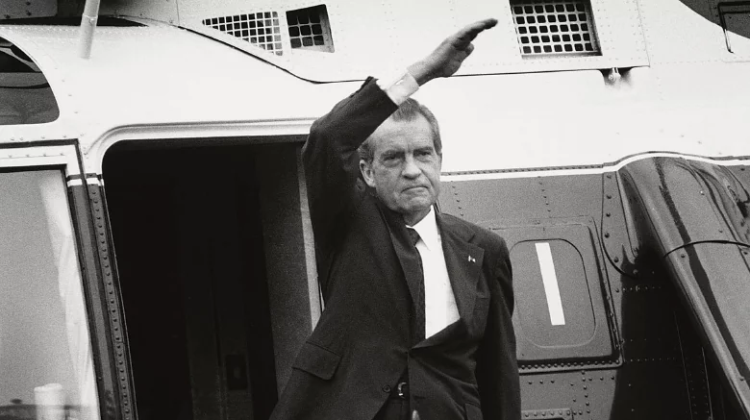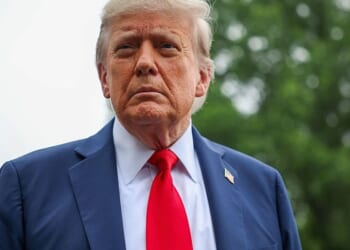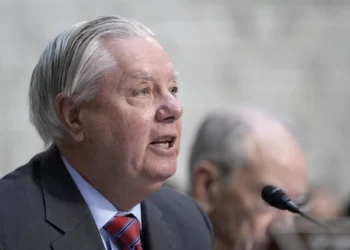
[Want even more content from FPM? Sign up for FPM+ to unlock exclusive series, virtual town-halls with our authors, and more—now for just $3.99/month. Click here to sign up.]
Michael Patrick Leahy’s new 90-minute documentary How the Deep State Took Down Richard Nixon comes three years after John O’Connor’s book The Mysteries of Watergate, which at the time I reviewed enthusiastically here at FrontPage Magazine. O’Connor’s account of the political scandal of the century was explosive. The 1976 movie All the President’s Men had presented Washington Post reporters Bob Woodward and Carl Bernstein as heroes of freedom who’d uncovered a nefarious conspiracy by the Nixon White House against the Democratic Party. In fact, as Woodward and Bernstein soon discovered, Watergate had been a CIA operation carried off without Nixon’s knowledge or approval; yet the Post, whose managing editor, Ben Bradlee, had been a close friend of JFK (in 2000, he published a cozy memoir entitled Conversations with Kennedy), was not out to nail the CIA but to bring down Nixon.
As for the cover-up, Nixon had pursued it because his counsel John Dean urged him to do so – not because it was beneficial for the Nixon administration but, at least in large part, because Dean, who had been instrumental in the planning of the Watergate burglary, wanted to save his own skin. In 1980, when Watergate burglar G. Gordon Liddy published his memoirs under the title Will, the Post, in an editorial, dismissed his assertion that the break-in had been “not an attempt to collect political intelligence on President Nixon’s enemies, but an effort master-minded by then White House counsel John Dean to steal pictures of prostitutes.” Yet Liddy was telling the truth, and the Post’s editors knew it. Summing the situation up in his book, O’Connor wrote that the Post was “guilty of a cover-up far more significant than Nixon’s.”
In my account of O’Connor’s book, I also discussed, in passing, Geoff Shepard’s then recent book The Nixon Conspiracy: Watergate and the Plot to Remove the President. It’s less sensational and more sober than O’Connor’s book, but no less damning. Shepard, who had been a young lawyer in the Nixon White House, focused not on the CIA angle or the Post’s perfidy or the reasons for the Watergate break-in, but rather on the way in which anti-Nixon members of the Deep State – people with high-level positions in the judiciary, executive, and legislative branches, as well as in the media – collaborated to destroy the Nixon presidency.
Leahy’s documentary, which can be viewed at Steve Bannon’s warroomfilm.com, is based almost entirely on Shepard’s decades of research into the toppling of a president who had just been re-elected in an unprecedented landslide, receiving the electoral votes of 49 states while his opponent won only Massachusetts and the District of Columbia. Shepard receives a great deal of screen time in this film, and Leahy does an impressive job of breaking down his findings category by category, spelling out the anti-Nixon perfidy in a way that makes the labyrinthine tale of Watergate, which has a list of characters that rivals War and Peace, easy to follow. The film’s thesis, spelled out at the beginning, is unequivocal: “The Deep State,” we’re told, “took down Richard Nixon through a coordinated whole-of-government assault” – one that was sold to the public by network news organizations and a few major newspapers that, at the time, spoke on such matters with a single voice and to which there were no significant dissenting voices of the sort that the Internet has made possible.
Leahy opens with a simple question: who knew, beforehand, about the Watergate break-in? Not Nixon, for one. The plan had been proposed by Liddy, and John Mitchell, the Attorney General turned campaign manager, knew about the proposal but didn’t approve it. It was Jeb Magruder, Mitchell’s deputy at the Committee to Re-Elect the President, who authorized the famous break-in of the DNC headquarters – which was, in fact, the second break-in, its objective being to replace a broken bug that had been placed there during the first break-in. As for Dean, who during the Senate hearings was portrayed as a heroic whistleblower, it was he who had hired Liddy in the first place to break into DNC headquarters. It was Dean, too, who after the arrest of the Watergate burglars launched the coverup, principally to cover his own ass. Indeed, according to Shepard, Dean was responsible for 95% of the activities that the coverup entailed.
From the beginning, the Watergate defendants couldn’t win. Yes, Nixon had just won an overwhelming re-election victory – but the Watergate grand jury drew exclusively on residents of the District of Columbia, 80% of whose electorate had voted for McGovern. The judge who presided over this farce, John Sirica, was notorious for his failure to follow proper procedures and for the frequency with which his rulings were overturned. (He ended up being named Time’s Man of the Year.) The special Watergate prosecutor, Archibald Cox – who was a labor lawyer, not a prosecutor – was an old Kennedy hand who had written speeches for JFK and served as JFK’s Solicitor General; one could hardly imagine a more politically partisan choice.
Cox was appointed by Nixon’s Attorney General Elliott Richardson, but was really hand-picked by Senator Ted Kennedy, who persuaded the spineless Richardson to establish an “entirely independent special prosecution force” and to give them unprecedented power; in short, the prosecution team was “created within the Nixon White House to take the Nixon administration down.” That team, moreover, consisted of 92 “highly partisan” lawyers – a number that later grew to 156 – who “all knew each other” (many of them had backgrounds in JFK’s Justice Department) and who shared an intense contempt for Nixon. As Shepard puts it, it was an “outrageous prosecution setup.”
Shepard’s account is in large part a stunning litany of profoundly illegal activities by the anti-Nixon forces. There were several “ex parte meetings” – that is, meetings between the judge and prosecutors without the knowledge or presence of the defendants. Flagrant violations of due process abounded. In a move unprecedented in all of American history, for example, Cox met secretly with the head of the D.C. circuit court to ensure that any appeals court reviewing Sirica’s pro-prosecution rulings would consist of nine judges instead of the usual three, thereby dramatically decreasing the possibility of reversal. As for Sirica, he “violated the Brady Rule, which requires the prosecution to turn over exculpatory evidence to the defense.” His line of questioning of potential jurors was patently designed to enable them to refrain from admitting their anti-Nixon bias. And the “most brazen due process violation” of all was Sirica’s decision to preside over the trial himself.
Then there was the role of Woodward and Bernstein. Woodward had met and befriended FBI Associate Director Mark Felt, to whom he gave the cover name “Deep Throat,” two years before Watergate; it was Felt who was running the Watergate investigation, and together the G-Man and the reporter “packaged” the information that the former leaked to the latter in such a way as to serve both men’s objectives. As for Bernstein, he “intentionally compromised the secrecy of the Watergate grand jury” by illegally interviewing one of its members – a fact that was kept secret for 45 years.
In short, everything having to do with the handling of Watergate by Deep State actors in all three branches of government was obscenely politicized. As Leahy points out, the similar attempt by today’s Deep State to bring down Donald J. Trump proved unsuccessful partly because the media (thanks to the Internet) are no longer an all-powerful monolith and partly because Trump, unlike Nixon, had the resources to fund his own legal defense. No, the story told in Leahy’s film isn’t as sexy as the one outlined in John O’Connor’s The Mysteries of Watergate. What it is, however, is an impressive forensic study that illuminates, point by point, the specific ways in which a wide range of purportedly distinguished but criminally inclined inside-the-Beltway figures conspired to destroy a president who had just been returned to office by an electoral margin of 520 to 17. To watch this film is to be doubly grateful that Donald Trump managed to triumph over the gang of high-placed crooks who tried – and tried, and tried, and tried – to do much the same thing to him.














